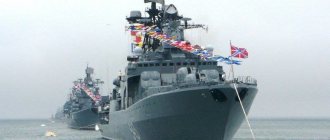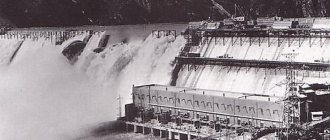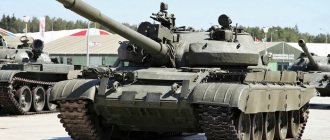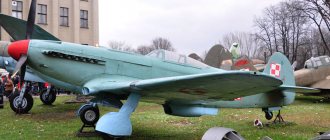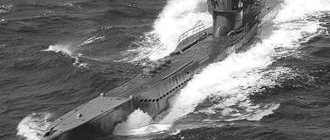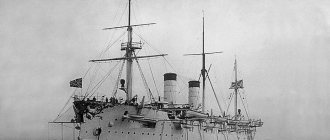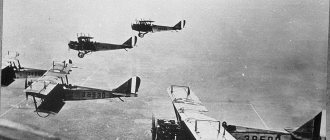Author: IdIuaM
15 November 2022 23:07
Tags: ships cruisers fleet
2686
23
In the second half of the twentieth century, 180 independent states appeared on the world map, but out of this wild diversity of countries and peoples, only two superpowers had a powerful ocean fleet - the Soviet Union and the United States. For example, no one except us and the Americans built missile cruisers en masse.
0
See all photos in the gallery
Four more European countries, in order to maintain their former status as “maritime powers,” made efforts to create their own missile cruisers, but all their attempts ended in the construction of a single ship with predominantly American weapons and systems. “Ships of prestige”, nothing more. The Americans were pioneers in the field of creating missile cruisers; by the end of the 40s, their military industry had created the first combat-ready air defense systems suitable for installation on a ship. Subsequently, the fate of the US Navy's missile cruisers was determined exclusively by escort functions as part of aircraft carrier groups; American cruisers were never designed for a serious naval battle with surface ships. But missile cruisers were especially respected in our country: during the existence of the USSR, dozens of different designs appeared in the vastness of the World Ocean: heavy and light, surface and underwater, with a conventional or nuclear power plant, there were even anti-submarine cruisers and aircraft carrier cruisers! It is no coincidence that missile cruisers became the main striking force of the USSR Navy. In a general sense, the concept of “Soviet missile cruiser” meant a large multi-purpose surface ship with a powerful anti-ship missile system. The story of the seven best missile cruisers is just a brief excursion into maritime history associated with the development of this unique class of warships. The author does not consider himself entitled to give any specific ratings or create a rating of “the best of the best.” No, this will just be a story about the most outstanding designs of the Cold War era, indicating their known advantages, disadvantages and interesting facts associated with these death machines. However, the nature of the presentation of the material will help the reader independently determine which of this “magnificent seven” is still worthy of the highest pedestal.
Albany-class guided missile cruisers
1944/1962 Total displacement 17,500 tons. Crew 1200 people. Full speed – 32 knots. Cruising range - 9000 miles (at 15 knots). Armament: - Talos long-range air defense system (2 launchers, ammunition 104 missiles); — Tartar short-range air defense system (2 launchers, ammunition 84 anti-aircraft missiles); — anti-submarine missile system ASROC (ammunition 24 missile torpedoes); - 8 Polaris intercontinental ballistic missiles (never installed); — two universal guns of 127 mm caliber.
×
0
Three American monsters, rebuilt from heavy cruisers of World War II. After the first successful experiments with missile weapons, the US Navy decided on a global modernization of the Baltimore-class artillery cruisers - they removed all weapons from the ships, cut off the superstructure and tore apart their insides. And so, 4 years later, an incredible “thug” with a tall superstructure and mast pipes studded with secret electronic equipment entered the sea. The fact that this ship was once a heavy artillery cruiser of the Baltimore class was only reminiscent of the shape of the bow. Despite its ugly appearance, the “Albany series” of cruisers were cool warships capable of providing high-quality air defense of aircraft carrier formations in the near zone (by the standards of those years) - the firing range of the Talos air defense system was more than 100 km, and two hundred missiles on board allowed fend off enemy aircraft for a long time. Advantages: - 15-centimeter armor belt, inherited from the heavy cruiser "Baltimore", - 8 fire control radars, - high installation height of radars, Disadvantages: - lack of strike weapons, - superstructures made of aluminum alloys, - archaic, in general, design.
0
0
Baltimore-class heavy artillery cruiser - this is what the Albany cruisers looked like before modernization
0
Specifications
Scheme of TARKR "Peter the Great"
The main performance characteristics of Peter the Great include:
- Length - 250.1 m;
- Width at the waterline - 25 m;
- Height from the level of the main plane - 59 m;
- Draft - 10.3 m;
- Standard displacement - 23,750 tons;
- Total displacement - 25,860 tons;
- Maximum speed is 32 knots.
Belknap-class guided missile cruisers
1964 Total displacement 8,000 tons. Crew 380 people. Full speed – 32 knots. Cruising range - 7000 miles (at 20 knots). Armament: - universal launcher Mk.10 (80 anti-aircraft and anti-submarine missiles); — automated artillery mount Mk.42 127 mm caliber; — 3 unmanned anti-submarine helicopters DASH (later replaced by the conventional SH-2 Sea Sprite helicopter); — two auxiliary guns of 76 mm caliber (later replaced by Phalanx anti-aircraft guns); - 8 Harpoon anti-ship missiles (added after modernization in the early 1980s).
0
A series of 9 light escort cruisers, on which great hopes were pinned - already at birth, the Belknap-class cruisers received a universal complex of naval weapons, including the original computerized BIUS, unmanned helicopters and a new under-keel hydroacoustic station AN/SQS-26, supposedly capable hear the propellers of Soviet boats tens of miles from the side of the ship. In some ways the ship justified itself, in others it did not, for example, the daring project of the unmanned helicopter DASH turned out to be of little use for real use on the open sea - the control systems were too imperfect. We had to expand the hangar and helipad to accommodate a full-fledged anti-submarine helicopter. It is noteworthy that after a short disappearance, 127 mm guns returned to the ship - the American sailors did not dare to completely abandon artillery. In the 60s...70s, cruisers of this type regularly patrolled off the coast of Vietnam, firing anti-aircraft missiles at North Vietnamese MiGs that carelessly flew into the cruisers’ kill zone. But the Belknap became famous not for its feats of arms - in 1975, the lead ship of this type was crushed in the Mediterranean Sea by the aircraft carrier John F. Kennedy. Its navigational error cost the cruiser dearly - the flight deck of the aircraft carrier literally “cut off” all the superstructures, and a shower of kerosene from the torn fuel lines of the aircraft carrier fell on top of the mangled remains of the ship. The ensuing eight-hour fire completely destroyed the cruiser. The restoration of the Belknap was a purely political decision, otherwise such a stupid death of the ship could undermine the prestige of the US Navy. Advantages of the Belknap: - computerized combat information and control system NTDS; — availability of a helicopter on board; - small size and cost. Disadvantages: - the only launcher, the failure of which would leave the ship essentially unarmed; — fire hazardous aluminum superstructures; — lack of strike weapons (which, however, is dictated by the purpose of the cruiser).
0
0
Burnt out Belknap
Get started with a running start
Apart from submarines, to which nuclear reactors gave fundamentally new tactical and operational capabilities, the world's first nuclear-powered submarine was civilian: the Soviet icebreaker Lenin (1959). The Americans launched the merchant ship Savannah, Germany launched the Otto Hahn (both in 1964). The Japanese spent 25 years building their Mutsu, delivered it in 1990, and in 1995 they already wrote it off, never having used it for commercial purposes. Around the same time (1988), the USSR built the nuclear-powered icebreaker lighter carrier Sevmorput in Crimea.
The rest of the surface ships were military, with the exception of nuclear icebreakers - a special, spatially and geographically determined type of vessel. The design of nuclear-powered warships on both sides of the ocean began almost simultaneously (1955-1956).
In the United States, the nuclear-powered aircraft carrier Enterprise (1961), with a displacement of about 95 thousand tons, was supposed to be the lead in a series of six units. But swelling budgets and the desire to accumulate experience in operating nuclear ships stopped serial construction for 10 years, and “Big E” was left alone.
The ship was distinguished by a multi-echelon power plant of eight A2W type reactors, borrowed with minimal changes from boat designs. Subsequently, the Americans were no longer keen on such experiments on duplicating and dispersing the load in the body due to their high cost. And technology has improved.
Project 58 missile cruisers (code "Grozny")
1962 Total displacement 5,500 tons. Crew 340 people. Full speed – 34 knots. Cruising range - 3500 miles (at 18 knots). Armament: - anti-ship complex P-35 (2 launchers, ammunition 16 anti-ship missiles); — short-range air defense system M-1 “Volna” (16 anti-aircraft missiles); — two automatic twin guns of 76 mm caliber; — 6 torpedoes of 533 mm caliber; — 2 x 12 RBU-6000 rocket launchers; - Helipad
0
Nikita Khrushchev's favorite ship. A small Soviet cruiser with colossal striking power for its size. The world's first warship equipped with anti-ship missiles. Even with the naked eye it is noticeable how overloaded the baby was with weapons - according to the plans of those years, “Grozny” had to almost alone carry out watches in the far latitudes of the World Ocean. You never know what tasks may arise for the Soviet cruiser - “Grozny” must be ready for anything! As a result, a universal weapon system appeared on board the ship, capable of fighting any air, surface and underwater targets. Very high speed - 34 knots (more than 60 km/h), universal artillery, equipment for receiving a helicopter... But what was especially impressive was the P-35 anti-ship complex - eight four-ton blanks, capable of falling off the guides at any moment and rushing beyond the horizon at supersonic speed (firing range - up to 250 km). Despite doubts about the long-range target designation capabilities of the P-35, powerful electronic countermeasures and anti-aircraft fire from American AUGs, the cruiser posed a mortal threat to any enemy squadron - one of the four missiles from each launcher had a megaton “surprise”. Advantages: — exceptionally high saturation with fire agents; - great design. Disadvantages: Most of the disadvantages of the Terrible were in one way or another related to the desire of the designers to place the maximum number of weapons and systems in the limited hull of the destroyer. — short cruising range; — weak air defense; - imperfect weapon control systems; — fire hazardous design: aluminum superstructure and synthetic interior finishing.
0
USSR naval power
0
The main armament of the cruiser
20 supersonic anti-ship missiles P-700 "Granit"
High-precision anti-ship cruise missiles "Granit" on the "Peter the Great" are located in 20 SM-233 launchers under the upper deck. Rocket length - 10 m, caliber - 0.85 m, launch weight - 7 tons. The warhead is a monoblock in nuclear (500 kilotons) or conventional (750 kg of explosive) ammunition, and can also carry a volumetric explosion fuel-air warhead. Firing range - up to 625 km, flight speed - up to 2.5 M (at altitude) and up to 1.5 M at the surface of the water.
These missiles have an integrated-autonomous control system: their flight is coordinated by the “leader”, if he is defeated by missile defense means, his functions are automatically transferred to the new leader. In combination with radio interference and decoys, a full-scale salvo of Granites from the Peter the Great becomes almost irresistible, with at least serious damage to the main target.
Anti-aircraft systems
| Characteristics | S-300 "Fort" | S-300 "Fort-M" | SAM "Dagger" | ZRAK "Dirk" |
| Number of PU | 6 | 6 | 16 | 6x8 |
| Missile stock | 48 | 48 | 128 | 144 |
| Range, km | Up to 150 | Up to 200 | 1,5-12 | 1,5-8 |
| Target engagement altitude, km | 0,025-25 | 0,01-25 | 0,01-6 | 0,005-3,5 |
| Warhead mass, kg | 145 | 180 | 15 | 9 |
Anti-aircraft missile systems (SAM) S-300 “Fort” and “Fort-M” are respectively located in the stern and bow of the cruiser “Peter the Great”.
Anti-aircraft weapons
The artillery component of the anti-aircraft weapons includes 30-mm automatic six-barreled AK-630 mounts as part of the Kortik air defense system (two in each launcher) with a total ammunition capacity of 48 thousand shells. The total rate of fire of these installations is about 10 thousand rounds per minute, the parameters for effective firing at air targets are 500-4000 m in range and 5-3000 m in altitude. Muzzle covers are placed on the barrel blocks to protect the installation and containers with missiles from powder gases. The first-stage ammunition is placed in two drums of 500 rounds of ammunition next to the barrel blocks; the machine guns are powered not by a belt, but by a screw (linkless).
Artillery part of the weapon
The basis of the Peter the Great's artillery armament is the twin 130-mm AK-130 multi-purpose artillery mount, capable of hitting coastal, sea and air targets. The barrels have a length of 70 calibers and a maximum elevation angle of 85 degrees, which ensures a gun range of up to 25 km. Rate of fire - from 20 to 90 rounds per minute. The mass of explosives contained in high-explosive fragmentation shells with various types of fuses is 3.56 kg. The ammunition prepared for firing includes 180 shells, and their total ammunition on the ship is 840 shells.
The guns can operate in fully automatic control and aiming mode, as well as in manual mode. The MP-184 fire control system allows for simultaneous tracking and firing of two targets.
"Peter the Great" has reliable protection against surprise attacks from the air and from under water
Anti-submarine weapons
The cruiser's anti-submarine weapons are equipped with the Vodopad-NK anti-submarine missile system, the Udav-1 anti-torpedo system, RBU-1000 missile and bomb launchers and Ka-27PL helicopters.
The Vodopad-NK anti-submarine missile system has 20 anti-submarine missiles capable of operating at a range of up to 50 km and carrying either a nuclear charge or a small-sized homing torpedo UGMT-1, with a speed of up to 41 knots. Firing is carried out from 10 launchers (PU) - 533 mm caliber missile and torpedo tubes. After this, the missile launches into the air from the water surface and delivers its warhead to the target area.
The Udav-1 anti-torpedo system is equipped with 40 missiles for firing from 10 RBU launchers (rocket-propelled bomb launchers) with a caliber of 300 mm, capable of hitting enemy torpedoes and submarines at a distance of up to 3 km. The cruiser Admiral Kuznetsov has a similar system.
The Smerch-3 anti-torpedo protection system, which includes:
- two six-tube remotely guided anti-submarine missile launchers RBU-1000 (ammunition capacity of 102 missiles with a range of up to 1 km and a charge weight of 55 kg);
- charger;
- RSL-10 depth charges;
- the “Storm” system, which controls the fire of up to four RBUs.
Two Ka-27PL helicopters are also designed for anti-submarine protection, equipped with anti-submarine equipment: search radar, sonobuoys, acoustic system and magnetic anomaly detectors. The third of the Ka-27 cruisers is equipped as a search and rescue helicopter. But all three aircraft can be armed with anti-submarine torpedoes, bombs, mines, and anti-ship missiles.
Cruiser "Peter the Great"
Missile cruiser Long Beach
1961 Total displacement 17,000 tons. Crew 1160 people. Full speed - 30 knots. Cruising range - 360,000 miles. Armament: - Terrier medium-range air defense system (2 launchers, 102 missiles ammunition) - Talos long-range air defense system (1 launcher, 52 missiles ammunition) - ASROC anti-submarine missile system (24 missile torpedoes ammunition) - two universal 127 mm caliber guns; - two Phalanx anti-aircraft guns, 8 Harpoon anti-ship missiles, 8 Tomahawk missiles (modernized in the early 1980s).
0
The world's first nuclear-powered cruiser is undoubtedly worthy of mention in the list of the best ships of the 20th century. In combination, Long Beach became the world's first specialized missile cruiser - all previous designs (Boston-class missile cruisers, etc.) were just improvisations based on artillery cruisers of World War II. The ship turned out to be gorgeous. Three missile systems for various purposes. The unusual “box-shaped” shape of the main superstructure, dictated by the installation of SCANFAR phased radars, also unique radio systems of its time. Finally, the nuclear heart of the cruiser, which made it possible to accompany the nuclear aircraft carrier Enterprise everywhere, for interaction with which this miracle was created. However, an incredible price was paid for all this - 330 million dollars (about 5 billion at the current exchange rate!), In addition, the imperfection of nuclear technology did not allow the creation of a compact nuclear power system of the required power in the 50s - the cruiser rapidly “grew” in size, finally reaching 17 thousand tons. Too much for an escort ship! In addition, it turned out that Long Beach did not have the opportunity to realize their advantage in practice. Firstly, the ship's autonomy is limited not only by its fuel reserves. Secondly, the aircraft carrier’s retinue included many ships with conventional power plants, which made it difficult for the nuclear cruiser to move quickly.
0
Long Beach served honorably for 33 years. During this time, he left a million nautical miles astern, while managing to fight in Vietnam and Iraq. Due to its exceptional complexity and cost, it remained the lonely “white elephant” of the fleet, however, it had a significant influence on the development of world shipbuilding (including the birth of our next “hero”). Advantages of Long Beach: - unlimited autonomy in terms of fuel reserves; — radars with phased array; - versatility. Disadvantages: - monstrous cost; - less survivability compared to conventional cruisers.
0
The history of the appearance of TARKR "Peter the Great"
In the mid-1960s, the Soviet Union began designing a new type of surface combat ship with a virtually unlimited range.
Initially, it was planned to create an anti-submarine ship with a displacement of about 8 thousand tons with a nuclear power plant. However, after the appearance in the late 1960s of US Navy submarines with intercontinental missiles and nuclear power plants, it was necessary to create a larger multi-purpose cruiser compared to the previously designed one.
As a result, design work began on Project 1144, the goal of which was to create a heavy nuclear-powered missile cruiser (TARK). The project, called "Orlan", was completed in 1972. Initially, Project 1444 “Orlan” was supposed to build seven ships with a nuclear power plant (NPP). Since 1973, cruisers of this type were laid down and built at the Baltic Shipyard: “Kirov”, “Frunze” and “Kalinin”, and since 1992 they began to be called “Admiral Ushakov”, “Admiral Lazarev” and “Admiral Nakhimov”, respectively.
The shipyard began construction of the next ship, which was destined to become the last in the TARKR series, in April 1986. By the time of its construction, the project had been modernized, receiving the designation 1444.2. The design of the ships did not change; compared to its predecessors, each new cruiser was equipped with more modern weapons systems. When laid down, the ship was called “Kuibyshev”, then for a short time it bore the name “Yuri Andropov”. Ultimately, the most powerful cruiser in the world, launched in 1989, was finally completed after the collapse of the USSR.
10 years after the start of construction, TARKR was able to begin sea trials, conducting them in the harsh conditions of the Arctic. After their completion, the nuclear-powered cruiser, which received the name “Peter the Great” in 1992, was transferred to the Northern Fleet of the Russian Navy, receiving hull number 099. The beginning of the cruiser’s combat service in the Russian fleet dates back to the moment the naval flag was raised on it, which took place on April 18, 1998 .
By that time, the first two cruisers of the Orlan project were decommissioned in the 1990s, and Admiral Nakhimov was mothballed for many years. Since 2013, work has begun on this cruiser on its deep modernization with the aim of re-equipping it with more modern types of weapons, but this process cannot be expected to be completed before 2022.
Heavy nuclear missile cruiser pr. 1144.2 (code "Orlan")
1980 Total displacement 26,000 tons. Crew 635 people. Full speed – 32 knots. Cruising range is not limited by fuel reserves. Armament: - anti-ship complex "Granit" (20 launchers, ammunition 20 missiles); — long-range air defense system S-300F “Fort” (6 launchers, ammunition 48 missiles); — long-range air defense system S-300FM “Fort-M” (6 launchers, ammunition 46 missiles); — short-range air defense system “Dagger” (12 launchers, ammunition 128 missiles); — anti-submarine complex “Waterfall” (ammunition of 20 missile torpedoes); — one twin automated artillery mount of 130 mm caliber; — 6 anti-aircraft missile and artillery complexes “Kortik”; — three rocket launchers; - three helicopters.
0
For comparison, the TAVKR "Peter the Great" was chosen - the last and most advanced of the heavy nuclear-powered missile cruisers of the "Orlan" type. A real Imperial cruiser with an amazing array of weapons - the entire range of systems in service with the Russian Navy is collected on board. Theoretically, in one-on-one combat, the Orlan has no equal among all the ships in the world - a huge ocean killer will be able to deal with any enemy. In practice, the situation looks much more interesting - the enemy against whom the “Eagles” were created does not go alone. What awaits the Orlan in a real battle with an aircraft carrier and its escort of five missile cruisers? Glorious Gangut, Chesma or the terrible Tsushima pogrom? Nobody knows the answer to this question. The appearance of the first Orlan in 1980 greatly excited the whole world - in addition to its cyclopean size and heroic stature, the Soviet heavy cruiser became the world's first warship with below-deck vertical launch systems. The S-300F anti-aircraft complex caused a lot of fear - nothing like it simply existed in any country in the world at that time. In fact, the first ship with the S-300F experimental complex installed was the Azov BOD. In addition, the S-300F guides are not installed completely vertically, but at an angle of 5° to the normal to prevent the rocket from falling onto the deck if the launch engine fails. As in the case of the American “Long Beach”, when discussing “Orlan” the opinion is often heard about the adequacy of creating such a Miracle. Firstly, nuclear missile submarines Project 949A look more attractive for destroying AUGs. The submarine's stealth and security are an order of magnitude greater, the cost is lower, and the 949A salvo contains 24 Granit missiles. Secondly, 26 thousand tons of displacement is a direct consequence of the presence of nuclear reactors, which do not provide any real advantages, only wasting space, complicating maintenance and worsening the survivability of the ship in battle. It can be assumed that without the YSU, the displacement of the Orlan would have been reduced by half.
0
0
WE BUILDED, BUILDED...
The construction of cruisers was carried out in Leningrad (St. Petersburg), where the world's first surface vessel with a nuclear power plant, the icebreaker Lenin, was built.
The first of the Orlans, called Kirov, was laid down on March 27, 1973. The launch took place on December 27, 1977, and on December 30, 1980, the cruiser was handed over to the USSR Navy. Was in combat composition of the Northern Fleet. In 1984 he made his first long trip to the Mediterranean Sea. During the second long-distance voyage (December 1, 1989 – February 17, 1990), the ship’s bow reactor failed, after which it was transferred to reserve. In 1992, the ship was renamed Admiral Ushakov, and on September 19, 1999 it was docked for disposal. The second ship of the series, Frunze (since 1992, Admiral Lazarev), was built according to the modernized project 1144.2. Laid down on July 27, 1978, launched on May 26, 1981, and entered service on October 31, 1984. Was in combat composition of the Pacific Fleet. It was declared unfit for combat and in 1999 it was withdrawn from the Navy into a state of long-term mothballing. Since June 2000, it was planned to begin repairs of the Admiral Lazarev at ship repair enterprises in the Far East. But there was not enough money in the budget.
The third - "Kalinin" (since 1992 - "Admiral Nakhimov") was laid down on May 17, 1983, launched on April 25, 1986, and entered service on December 30, 1988. Was in combat composition of the Northern Fleet. Made his last voyage in July 1997. On August 14, 1999, it was delivered for scheduled repairs and modernization to the Sevmashpredpriyatie berth in Severodvinsk. According to the schedule, the repairs were to be completed within 3–4 years. But due to underfunding, the work never actually began; only the equipment was slowly dismantled and sent to manufacturing plants. Only in 2008, the repair of the Admiral Nakhimov was included in the Rearmament Program with the ship being commissioned in 2012. At the end of September 2008, the unloading of spent nuclear fuel finally began. Representatives of the Nizhny Novgorod OKBM im. Afrikantov and the crew of a specialized vessel of the Belomorsk naval base.
The fourth "Orlan" - "Peter the Great" - was laid down on April 25, 1986 under the name "Kuibyshev". Later he received the name “Yuri Andropov”. Launched on April 25, 1989. Renamed "Peter the Great" on April 22, 1992. In November 1996, he came to Severodvinsk to conduct the second stage of testing at the site of permanent deployment, which lasted for two years. Included in the Northern Fleet in March 1998. The total cost of the cruiser was about $1 billion.
The nuclear power plant is equipped with two KN-3 fast neutron reactors of 300 MW each and two main turbo-gear units (GTZA) with a power of 70,000 hp each. every. In a backup version, GTZA can receive steam from two fossil fuel steam boilers operating in an automated mode. Coupling nuclear reactors with oil-fired steam superheaters increases the overall power of the installation and the speed of the ship (maximum speed is 31 knots, and 17 knots when sailing under auxiliary steam boilers). The power of the nuclear power plant is 140 thousand liters. With.
The ship has 1,600 rooms, including 140 single and double cabins for officers and midshipmen, 30 cabins for sailors and petty officers for 8–30 people each, 15 showers, two baths, a sauna with a swimming pool, a two-level medical unit, a gym with exercise equipment, three wardrooms - for midshipmen, officers and admirals, a lounge for relaxation, a ship's television studio. TARKR "Peter the Great" has increased navigation autonomy, is equipped with more effective hydroacoustic means, anti-submarine weapons and cruise missiles. The ship is equipped with the Kinzhal air defense system, the Kortik anti-aircraft missile and artillery system, and one of the two S-300F air defense systems has been replaced by the more advanced S-300FM. Strike missile weapons are represented by the Granit anti-ship missile system (ASMC) - 20 inclined launchers with P-700 supersonic anti-ship missiles.
Anti-submarine and anti-torpedo weapons include the Vodopad-NK anti-submarine missile system (universal missile-torpedo launchers with missiles), the Udav-1 anti-torpedo defense missile system with ammunition for 40 rocket depth charges, as well as three Ka-27PL or Ka anti-submarine helicopters -25RC.
"Peter the Great" was intended for operations in remote areas of the seas and oceans as part of an aircraft carrier strike group, which was to include an aircraft-carrying cruiser of the Admiral Kuznetsov type, a missile cruiser of the Slava type, a large anti-submarine ship of the Udaloy type, landing ships of the “Ivan Rogov” and support transports such as “Berezina” or “Boris Chilikin”.
The fifth TARKR - "Dzerzhinsky" - was withdrawn from funding and dismantled directly on the slipway.
There is, however, another “Orlan” - the secret “communications ship” “Ural”, which they try not to remember, since it is the biggest failure of Soviet shipbuilding (and not only shipbuilding).
The nuclear-powered electronic intelligence ship "Ural" was turned into a guardhouse. (Photo from the FAS website and from the HBO archive)
The nuclear-powered electronic intelligence ship "Ural" was laid down in the summer of 1981, launched in 1983, and accepted into fleet service in 1989. The full crew, including electronics specialists, is 1000 people. A huge computing complex consisting of several computers such as ES-1046 and Elbrus. The Coral surveillance system made it possible to track the trajectories of ballistic missiles and spacecraft. We can say that this floating reconnaissance center has absorbed all the latest developments in the Soviet radio-electronic industry. Being on a long-term autonomous voyage off the coast of America, the Ural could “see through” all American cosmodromes, training grounds and airfields. There would be no price for him if he were able to work.
After being commissioned, the Ural made a two-month journey to its home port of Vladivostok. All the way, large teams of specialists eliminated breakdowns of mechanisms and tried to debug the work of “Coral” and the computer. However, problems in the cooling system of the bow reactor turned out to be irreparable, as well as problems in the electronic equipment. In addition, a roll of five degrees arose, which also could not be eliminated. The ship anchored and turned into a floating guardhouse for penal prisoners and unpromising officers. Later, the Ural was moved to the factory wall, where it will await disposal for a long time. Unique equipment with a high content of precious metals has been mostly “recycled” for two decades. However, now such equipment will only be of interest to a museum.
Ticonderoga-class guided missile cruiser
1986 Total displacement 10,000 tons. Crew 390 people. Full speed – 32 knots. Cruising range – 6000 (at 20 knots). Armament: - 122 vertical launchers Mk.41 (launching almost all types of missiles in service with the US Navy, with the exception of submarine-launched ballistic missiles); — 8 anti-ship missiles “Harpoon”; — two lightweight universal artillery systems Mk.45 of 127 mm caliber; — six anti-submarine torpedoes of 324 mm caliber; - two Phalanx anti-aircraft guns; - two Bushmaster automatic cannons of 25 mm caliber.
0
“Stand by admiral Gorshkov: “Aegis” - at sea!” - “Beware, Admiral Gorshkov: Aegis is at sea!” — it was with this message that the first Ticonderoga, an unsightly ship from the outside, with the most modern electronic filling, set out to sea. For comparison, the cruiser CG-52 “Bunker Hill” was chosen - the lead ship of the second series of “Ticonderogas”, equipped with Mk.41 UVP. A modern ship thought out to the smallest detail with unique fire control systems. The cruiser is still focused on providing air defense and anti-submarine defense for aircraft carrier formations, but can independently launch massive strikes along the coast using Tomahawk cruise missiles, the number of which can reach hundreds on board. The highlight of the cruiser is the Aegis combat information and control system. Coupled with stationary phased radar panels AN/SPY-1 and 4 fire control radars, the ship's computers are capable of simultaneously tracking up to 1000 air, surface, and underwater targets, while automatically selecting them and, if necessary, attacking 18 of the most dangerous objects. At the same time, the energy capabilities of the AN/SPY-1 are such that the cruiser is capable of detecting and attacking even fast-moving point targets in low Earth orbit. Advantages of Ticonderoga: - unprecedented versatility at minimal cost; - enormous striking power; — the ability to solve missile defense problems and destroy satellites in low orbits; Disadvantages of the Ticonderoga: - limited size, and, as a result, dangerously overloaded ship; — widespread use of aluminum in the design of the cruiser.
0
0
Warship design
TARKR "Peter the Great" at the construction stage, unlike its nuclear-powered predecessor cruisers with almost similar characteristics, received increased autonomy (up to 60 days) and an unlimited cruising range. The cruiser's hull has 6 decks, and the superstructure has 8 tiers. In order to increase the survivability of the ship, the most important parts of its hull have armor with a thickness of 50 to 100 mm.
The total number of premises intended for the crew's living activities is about 1,600, including 140 cabins and 30 cockpits, 3 saunas, 15 showers, and a gym. The regular crew size is 1035 people, including 105 officers, 130 midshipmen, 800 sailors. 18 people are flight personnel.
The cruiser's main power plant is equipped with two fast neutron nuclear reactors with a thermal power of 300 MW each and two auxiliary oil steam boilers, which are designed to both increase the overall power of the ship's power plant and provide it with the ability to sail up to 1000 miles without the use of nuclear power plants. The ship's power system also includes 8 steam and gas generators, 4 power plants with a total capacity of 18 MW, and 2 turbines with 75 thousand horsepower.
The cruiser's two propeller shafts rotate along a five-blade propeller.
New in blogs
This data was declassified relatively recently, since at that time both sides decided not to make this incident public.
"Ocean-77" - a full-scale exercise of the USSR Navy in 1977, at a combat training ground in the Pacific Ocean, until a certain point, took place according to the command plan.
Two strategic bombers of the Soviet Union, Tu-16, took off to carry out a combat mission. One carried X-12 (anti-ship) missiles, the other was supposed to control their launch and provide guidance.
At this time, the Americans closely monitored the progress of the exercises. The ships of the 7th Fleet of the US Navy were located near the Soviet training ground.
When the American radar detected the bombers, the ARK CGN-25 Bainbridge was given the task of monitoring the operation of Soviet aircraft. The cruiser separated from the aircraft carrier group and moved to the training ground where the exercises were taking place.
At this time, the Tu-16 entered the desired area and launched the X-12. But the separation of the rocket from the carrier was not very successful; its tail section destroyed the antennas that provided two-way communication with the X-12.
As a result, instead of a climb program, the rocket continued its horizontal acceleration, with a slight roll... so the X-12’s trajectory followed an arc.
The bomber attempted to take control of the missile. To no avail. The dive command to destroy X-12 also led to nothing.
ARK USS CGN-25 "Bainbridge"
The emergency situation was reported to the command. To which there was a simple answer - due to the lack of options for neutralizing the missile, trace its path until it completely runs out of fuel and falls into the water.
ARK "Bainbridge" by that time had already entered the area that was designated as potentially dangerous near the exercise area and began reconnaissance. The ship's radar detected an air target moving from the training ground towards them, along an arcuate trajectory. The results of the analysis showed that she would pass the cruiser without entering the 10-mile safety zone. Conclusions - a runaway rocket. Happens. In general, the Americans did not assign it the status of a threat.
But in vain. X-12, having left the exercise area and without outside commands, automatically turned on the standard homing target search program. And, as you understand, having flown more than two hundred kilometers, it honed in on a US nuclear cruiser and changed course.
When the Bainbridge realized that the fugitive missile had changed course and was heading straight for the ship, that’s where the jokes about the Soviet exercises ended. They turned on the combat alarm and tried to take action to evade and neutralize the X-12.
But the most that the Americans managed was to set up a cloud of dipole reflectors and unsuccessfully shoot at the missile from anti-aircraft guns. It was too late to use anti-missile weapons - the moment was lost.
The X-12 hit the bow of the ship, pierced the hull and exploded. This led to widespread damage. A fire broke out. The warhead of the Terrier air defense system detonated.
The cruiser tilted on its bow and began to go under the water. The surviving sailors tried to put out the fire, but were unable to cope. We tried to seal the holes, but it didn’t work because of the fire.
Burning Bainbridge, photo from a Soviet search and rescue helicopter
Of the cruiser's crew, only 9 sailors survived, of the 11 who jumped overboard and were rescued by a Soviet helicopter. Two drowned. 27 people died on the ship itself. The survivors were taken to a US destroyer.
During the entire time that the out-of-control missile was flying, several communication sessions took place between the USSR and the USA, then there was an agreement to carry out joint rescue operations, and then a decision was made not to make this incident public.
All data on the incident with the Bainbridge ARK was classified for 25 years. Each of the participants signed a non-disclosure document... And now, after so much time, information on this event finally became public.
Following the USSR
The Americans, having produced a large series of nuclear cruisers in the 1970s, fell into a trap. As soon as this series was completed, the fleet began to receive gas turbine ships of the Aegis system: Ticonderoga-class cruisers, and then Arleigh Burke-class destroyers (essentially the same Ticonderogas, only cheaper). These were already next-generation ships, equipped with vertical launchers and new electronic systems.
Accordingly, a dilemma arose. On the one hand, nuclear-powered ships still have a life to live, but they need to be re-equipped. This is difficult and expensive, which means it must be combined with major repairs. Somehow they made it until the 1990s. But then the Cold War ended, and the White House began to cut military spending.
Nuclear cruiser "Virginia"
Photo: US Navy
There was something to be cut: the annual operation of a Virginia-class nuclear cruiser at those prices cost more than $40 million. For comparison: Burke’s is two times lower, and Ticonderoga’s is one third lower. At the same time, let us recall that the combat capabilities of nuclear cruisers were inferior to non-nuclear ones due to outdated weapons and radio electronics.
The combination of these factors, supplemented by newly emerging considerations set forth by skeptics back at the turn of the 50s and 60s, was resolved by a simple write-off, starting in 1995. By 1999, not a single nuclear-powered surface ship remained in the US Navy, except for aircraft carriers, which still causes muffled grumbling on American forums about Clinton, who cut up “such magnificent ships,” and, “undoubtedly, to please the Reds.”
